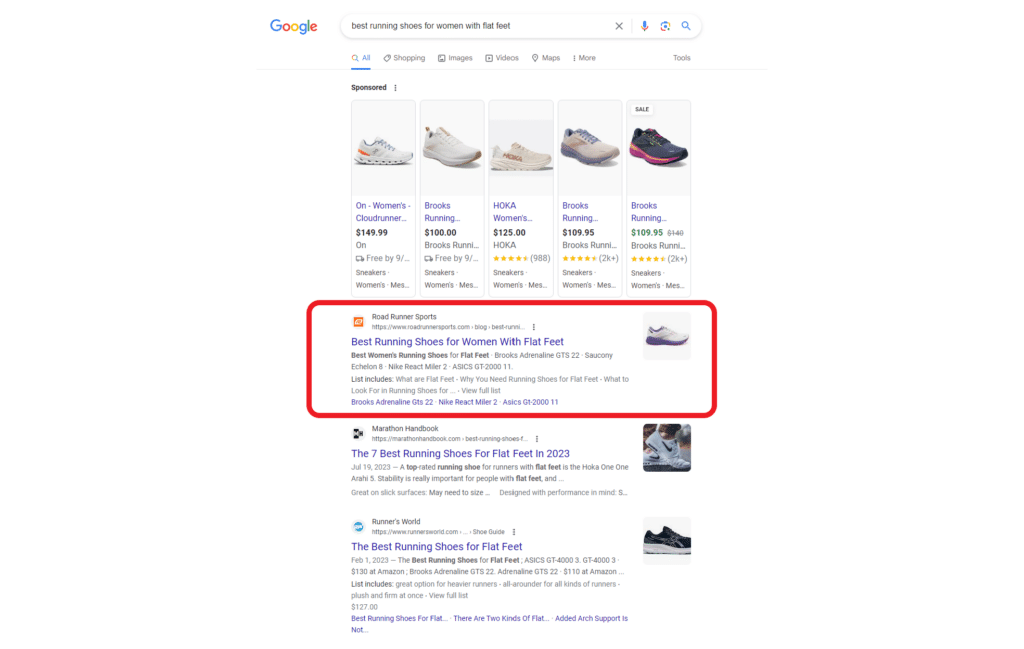
What You’ll Learn
- What Are Long-Tail Keywords?
- Benefits of Long-Tail Keywords
- How Do Long-Tail Keywords Work?
- 5 Strategies to Help You Identify Valuable Long-Tail Keywords
- FAQs on Long-Tail Keywords
What Are Long-Tail Keywords?
Let’s begin with the basics.
Long-tail keywords are highly specific search phrases that consist of three or more words. Unlike short keywords, which are broader and more competitive, long-tail keywords are laser-focused on a particular niche or topic. They cater to a more refined audience, addressing their specific needs and preferences.
Crafting articles focused on specific, less-explored search terms can significantly benefit your brand and revenue.
Why are these descriptive search terms called “long-tail keywords?” There’s a good reason for it, actually.
There’s such a thing as the search demand curve. It’s a line graph showing searches per month for the most (and least) popular keywords.
The search demand curve is a downward-sloping line as you examine it from left to right. On the left-hand side are the more popular search terms and on the right-hand are the less popular terms.

Long Tail Keywords
The graph appears to have a long tail on the right that represents about 70% of the search terms. That’s where the name comes from.
Keep in mind, though: that the search terms on the right of that graph aren’t necessarily 3 or more words in length. It’s just that the longer search terms tend to fall on that side of the graph.
Examples: Short vs. Long-Tail Keywords
To illustrate the concept, let’s compare short and long-tail keywords:
- Short-Tail Keyword: “Shoes”
- Long-Tail Keyword: “Women’s running shoes for flat feet”
The main difference between the two is specificity. Short-tail keywords are like casting a wide net, while long-tail keywords are like using a fishing rod with bait tailored to a particular type of fish.
Benefits of Targeting Long-Tail Keywords
Now that we know what long-tail keywords are, let’s explore why they should matter to your business.
1. Better ROI Over Time
Long-tail keywords often yield a higher ROI over time compared to shorter keywords. While short keywords may attract more traffic, they can be incredibly competitive, making it challenging to rank for them. Long-tail keywords, on the other hand, have less competition, allowing you to rank higher in search engine results pages with less effort and cost.
2. Less Competition Means Lower Costs
With less competition, bidding on long-tail keywords in paid advertising campaigns (such as Google Ads) tends to be more cost-effective. Lower bidding costs translate to higher profit margins for your business.
3. Easier to Rank in SERPS
Ranking for long-tail keywords is comparatively more straightforward. Since these keywords are highly specific, they align closely with the content on your website. Search engines favor relevancy, making it easier for your pages to rank higher when targeting long-tail keywords.

Top Spot in Google SERP for Long-Tail Keyword
4. Long-Tail Keywords Are Simpler to Target
Long-tail keywords allow you to tailor your content to match the exact intent of your target audience. This results in more engaged visitors who are more likely to convert into customers.
5. Match Audience Intent
Understanding user intent is crucial in digital marketing. Long-tail keywords inherently align with the intent of users who are further along in the purchasing journey. They are often used by individuals who are researching or ready to make a purchase, making them an ideal choice for capturing leads and driving sales.
So, How Do Long-Tail Keywords Work?
Now that we’ve covered the “what” and “why” of long-tail keywords, let’s delve into how they work and how you can harness their potential.
1. Generate Traffic
Long-tail keywords may not have the same search volume as short keywords, but they collectively contribute to a substantial portion of web traffic. This phenomenon aligns with the 80/20 rule, where roughly 80% of your traffic can come from 20% of your keywords.
2. Used to Target User Intent
Long-tail keywords are a powerful tool for targeting specific user intent. By understanding your audience’s needs and crafting content that addresses those needs, you can attract highly qualified traffic that is more likely to convert.
3. Strategic Placement
To make the most of long-tail keywords, it’s crucial to strategically incorporate them into your content. This means naturally integrating them into your articles, blog posts, and product descriptions to ensure they flow seamlessly within the text.
4. Topic Clusters
Long-tail keywords can be used to build topic clusters. This SEO strategy involves creating a pillar piece of content around a broad topic and then crafting multiple related pieces of content using long-tail keywords. This not only boosts your authority on the topic but also enhances your chances of ranking for various long-tail keyword variations.

Topic Clusters
5 Strategies to Help You Identify Valuable Long-Tail Keywords
Now that you understand the significance of long-tail keywords, let’s explore some effective strategies to discover them.
1. Utilize SEMRush
One of the most reliable tools for keyword research, SEMRush, offers a feature-rich platform to identify long-tail keywords. You can use it to explore keyword variations, assess their search volume, and analyze your competition.
2. Conduct Keyword Gap Analysis
Performing a keyword gap analysis allows you to identify keywords your competitors are ranking for but you are not. This can reveal valuable long-tail keyword opportunities that you can capitalize on.
3. Pay Attention to Google Search Features
Google itself can be a goldmine for long-tail keywords. Use Google’s autocomplete and related search suggestions to uncover long-tail keyword ideas directly from the search engine.
Just type in a generic search term and look for “Searches related to…” You’ll find several keywords that will, at the very least, get you pointed in the right direction.
In some cases, you’ll find long-tail keywords that you can use.
For example, head over to Google and search for “home theater systems.” Scroll all the way to the bottom of the page.
Check out the “Searches related to home theater systems” section. You’ll probably see search terms like “home theater systems with wireless speakers,” “wireless surround sound home theater systems,” “best wireless surround system.”

Google Search for Long Tail Keywords
Those are some great long-tail options. By the way, each one of those options is clickable. When you see the results for it, you can once again scroll to the bottom of the page and get even more ideas for long-tail keywords, without even leaving Google.
4. Do Your Topic Research
Consider using content research tools like BuzzSumo to discover topics and keywords that are currently trending in your industry.
Consider synonyms.
When you optimize for one long-tail keyword, you’re also optimizing for a variety of other long-tail keywords that each receive only a little bit of attention as well. The net result is an aggregation of a lot of unpopular search terms that can secure you more website visitors.
Google is extremely intelligent when it comes to comprehending the meaning of words. So it will use synonyms to find just the right match that will provide its users with the best experience. That means a search term that seems like a good fit for your article, even if it doesn’t use the exact keyword, could land that article at the top of the SERPS.
5. Leverage Google Ads Keyword Planner
Google Ads Keyword Planner is a handy tool for keyword research. It not only helps you find long-tail keywords but also provides data on search volume and competition, allowing you to make informed decisions.
FAQs
1. How often should I update my long-tail keyword strategy?
Regularly reviewing and updating your long-tail keyword strategy is essential. The digital landscape and user behavior evolve over time, so it’s crucial to stay current with trends and adapt your content accordingly. Aim to revisit your keyword research and strategy at least quarterly to ensure your content remains relevant and competitive.
2. Can long-tail keywords be used for voice search optimization?
Absolutely! Long-tail keywords are particularly well-suited for voice search optimization because they often mirror natural language queries. As voice-activated devices and virtual assistants become more prevalent, optimizing for long-tail keywords can help your content rank higher in voice search results.
3. Are long-tail keywords only relevant for content creators?
Long-tail keywords are valuable for a wide range of businesses and industries. They can benefit ecommerce stores, local businesses, service providers, and content creators alike. Any business looking to increase online visibility, attract targeted traffic, and improve conversion rates can benefit from incorporating long-tail keywords into their digital strategy.
Ignite Your SEO Strategy With Powerful Long-Tail Keywords
Long-tail keywords are a valuable asset in your digital marketing arsenal. They provide an avenue for businesses to reach a highly targeted audience, increase ROI, and drive notable revenue.
Our search engine optimization experts are eager to take the first steps toward driving notable traffic to your website and ensure your online presence stands out in the crowded digital landscape. So, don’t underestimate the power of long-tail keywords – they might just be the missing piece of your SEO.
Ready to learn more about our SEO services?